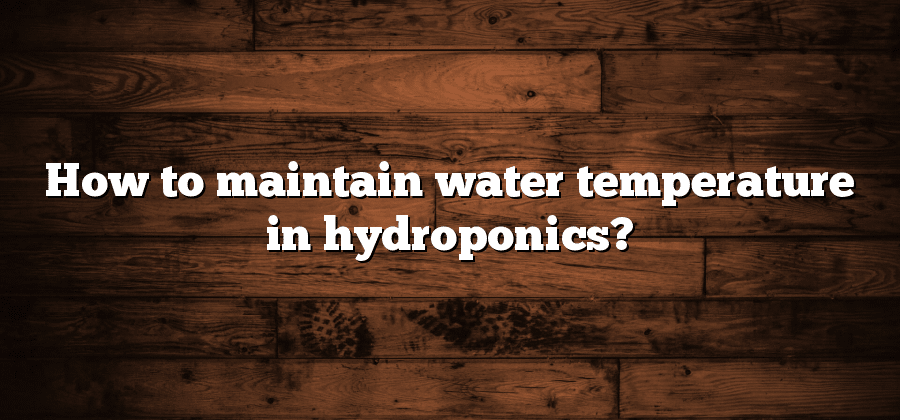Understanding the Importance of Water Temperature in Hydroponics
Water temperature plays a crucial role in the success of hydroponic systems. It directly affects the overall health and growth of the plants, and ignoring its importance can lead to poor results. Maintaining the right water temperature is essential in creating an optimal environment for the plants.
One key reason why water temperature is so crucial in hydroponics is that it affects nutrient uptake. Different plant species have different temperature requirements for optimal nutrient absorption. When the water temperature is too high or too low, the ability of the plants to absorb nutrients efficiently is compromised. This can lead to nutrient deficiencies or imbalances, which in turn negatively impact the overall health and productivity of the plants. Therefore, by understanding the importance of water temperature and managing it effectively, hydroponic growers can provide the ideal conditions for their plants to thrive.
Factors Affecting Water Temperature in Hydroponic Systems
Water temperature is a crucial factor when it comes to the success of hydroponic systems. There are several factors that can affect the water temperature, making it essential for growers to understand and address them accordingly. One of the primary factors influencing water temperature in hydroponic systems is the ambient air temperature. The surrounding environment plays a significant role in determining the temperature of the water. If the room where the hydroponic system is located experiences high temperatures, it can lead to an increase in water temperature. On the other hand, colder ambient temperatures can result in a decrease in water temperature. It is essential to keep in mind that maintaining the appropriate water temperature is vital for the optimal growth and development of hydroponic plants.
Apart from the ambient air temperature, another factor that affects water temperature in hydroponic systems is the use of artificial lighting. High-intensity lighting, such as metal halide or high-pressure sodium lamps, can generate a considerable amount of heat. This heat can transfer to the water in the system, causing an increase in temperature. The duration and intensity of the lighting play a role in determining the degree of heat transfer. It is important for growers to carefully consider the positioning and timing of their lighting systems to prevent the water temperature from exceeding the ideal range for hydroponic plants.
Choosing the Right Water Temperature for Hydroponic Plants
Hydroponic plants rely heavily on the water temperature for their growth and overall health. Choosing the right water temperature is essential in ensuring optimal nutrient uptake and avoiding any undesirable effects on the plants.
The ideal water temperature for hydroponic plants varies depending on the specific type of plants being grown. Generally, most plants prefer a water temperature between 65°F and 75°F (18°C to 24°C). This temperature range promotes the best nutrient absorption through the plant roots, allowing them to thrive and grow efficiently. However, it is important to note that certain plants may have specific temperature requirements, and it is essential to research the ideal temperature range for each plant species to achieve the best results in a hydroponic system.
Monitoring and Adjusting Water Temperature in Hydroponics
Proper monitoring and adjusting of water temperature is crucial in hydroponics to ensure optimal growth and productivity of plants. As water serves as the main medium for nutrient delivery in this system, its temperature directly impacts the overall health and vigor of the plants.
To effectively monitor water temperature in hydroponics, it is recommended to use a reliable thermometer specifically designed for water. This will provide accurate readings and allow growers to make necessary adjustments if the temperature deviates from the ideal range. Regularly checking the temperature of the water will help identify any sudden fluctuations or persistent patterns, enabling prompt action to maintain an optimal environment for plant growth.
The Role of Insulation in Maintaining Water Temperature in Hydroponics
Maintaining the optimal water temperature in a hydroponic system is crucial for the successful growth of plants. One effective way to achieve this is through the use of insulation. Insulation acts as a barrier that helps regulate and maintain the water temperature within the desired range.
When it comes to hydroponics, insulation is commonly used to prevent heat loss or gain from the environment. It acts as a protective layer, reducing the impact of external factors on the water temperature. By insulating the hydroponic system, growers can minimize temperature fluctuations, which can be detrimental to plant health and growth. Additionally, insulation can also help conserve energy by reducing the need for additional heating or cooling mechanisms, thus promoting sustainability in hydroponic setups.
To effectively utilize insulation in hydroponics, it’s important to consider the choice of materials. There are several options available, such as foam boards, reflective films, and insulating sleeves. Each material has its own unique properties and advantages, so it’s important to choose the one that best suits your system and requirements. The insulation material should be resistant to water and heat, and capable of maintaining a stable temperature within the hydroponic system. Additionally, properly installing and sealing the insulation will ensure its effectiveness in maintaining water temperature, providing a stable and ideal environment for plant growth.






